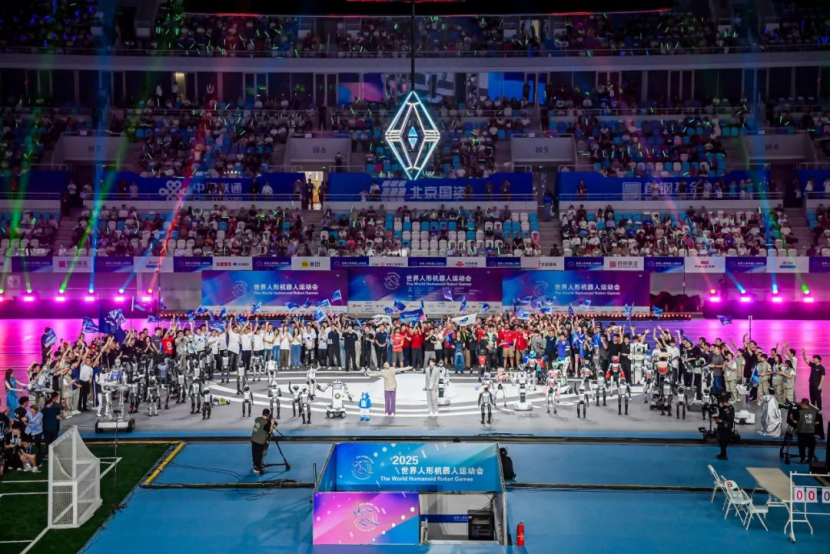
From August 14 to 17, 2025, the 2025 World Humanoid Robot Games will be held at the National Speed Skating Hall "Ice Ribbon". 280 teams from 16 countries competed in 487 competitions in 26 categories of four categories: competitive competition, exhibition competition, scene competition and external competition, demonstrating the capabilities of humanoid robots in intelligent decision-making, sports cooperation and other fields.
The enterprise team includes Tiangong, Yushu Technology, Accelerated Evolution, Loose Extension Power, Fourier, Xinghaitu, etc., covering the leading humanoid robot enterprises in China. In addition to competition, this event is more like a technical feast and is expected to become an important vane for the global humanoid robot industry and even the scientific and technological innovation ecology.
Humanoid robot "group debut"
At the opening ceremony, 15 humanoid robots Booster T1 and K1 from Chinese companies "accelerated evolution" appeared in a neat and uniform opening dance, with smooth movements and precise rhythm, directly occupying the C position of the stage, instantly igniting the audience.

But this is not the most explosive. Immediately afterwards, 25 Booster T1 robots, which had just helped the Chinese team win the Brazilian RoboCup championship, made their own appearance in the form of a 5×5 phalanx. This is the first time in human history that AI humanoid robots have autonomous phalanx - there is no remote control, no operator behind them to "escort", and it all depends on AI independent decision-making and coordination.
Why is this "walking phalanx" so good? To put it simply, it is difficult enough to let a robot walk on its own, and it is at least twice as difficult to have 25 robots walk in a square at the same time, at the same speed, at the same rhythm, and with zero error. Behind this are the test of high-precision positioning and synchronization capabilities, real-time communication and low latency compensation, formation control algorithms in complex environments, and stability and consistency of action execution.
It can be said that this is an "extreme stress test" of the comprehensive capabilities of the AI+ robot system. The Chinese team not only completed, but also won the championship, which was full of gold content. What's even more exciting is that a number of teams from the United States and Germany are also debugging the "accelerated evolution" Booster K1 model on the spot. Their feedback was surprisingly consistent: "Stability, openness, and compatibility exceeded expectations." ”
You know, top international competitions never easily use external hardware. Today, Accelerated Evolution can provide hardware support and technical services to more than 40 participating teams around the world, indicating that its product strength has been internationally recognized - not only technical output, but also standard output.
Moved the arena into the real world
In this robot games, not only did the phalanx and Tai Chi show off their skills, but also quietly did a big thing - moving the arena into the real world.

The organizing committee specially set up a "scene competition" to directly simulate four high-frequency rigid demand scenarios: factories, storage centers, hospitals, and hotels. The competition items are also particularly "down-to-earth": factory moving materials, hospital sorting of medicines, hotel cleaning services...... It is no longer an abstract algorithm competition, but a real test of "work ability".
Why these four scenarios? In a word: high demand, high repetition, and lack of manpower. In factories, robots can accurately assemble and handle heavy objects; In hospitals, they can distribute and deliver medicines 24 hours a day, reducing human error; In the hotel, welcome, delivery, and cleaning are all standardized services, which are most suitable for robots to "work".
These scenes are set up not only to look good, but also to verify whether the robot can really be "used". Whoever can operate stably in a real environment is more likely to be the first to commercialize.
Participating in the hotel cleaning competition this time was the viplab robot group from the Department of Automation of Tsinghua University (yes, it is the "predecessor team" of Qianjue Technology, similar to the Vulcan football team behind the accelerated evolution, academic + industrial double buff).
Why did they come to participate? Two keywords: technical confidence + business verification
Technical advantages: Instead of relying on preset paths to "follow the process", their robots rely on autonomous decision-making to respond to dynamic disturbances—such as sudden obstacles and temporarily changed tasks, they can handle them by themselves. This "generalization ability" is the real AI.
Business considerations: Hotels are typical business scenarios with high complexity and high dynamics. They want to use the competition to verify the feasibility of this system in a real environment and pave the way for the next step of commercialization.
Don't think it's just a show. In some real industrial scenarios, such robots have been deployed on a small scale, and the current model efficiency is stable at more than 70% of manual labor.
More importantly, this is not the end. It is expected that in the second half of 2025, customers will see results in batches; By 2026, the overall efficiency is expected to exceed 90%, approaching or even surpassing the level of human operation. This means that robots are no longer just "active", but more and more "capable", and the cost is lower, no mistakes, and no leave.
Embodied intelligence is still in its infancy
Does today's embodied intelligent robot look like a child who has just learned to walk? can walk, take things, and understand instructions, but they are still one breath away from "working independently". That's right, the current humanoid robot industry is in such a "toddler" stage - there are more technical demonstrations and less real landing; Pilot projects are on fire, and scale replication is difficult.
But this does not prevent major manufacturers from riveting their strength, uniting real users such as factories, hospitals, hotels, etc., while "patching", while optimizing the system: improving the flexibility of operations (such as screwing screws, opening bottle caps), strengthening the efficiency of human-machine collaboration (don't bump into people, don't grab lives, know how to cooperate), and ensure the safety of task execution (after all, no one wants to run a "robot killer" in the office).
China is no longer a "runner", but an important force in the global robot industry. We have a complete supply chain, rapid iteration of technical capabilities, and rich application scenarios - from Foxconn's factory to Homeinn hotels, they are the best "training grounds" for robots. The industrial chain, technical base, and application soil are all in place. Next, the competition is who can take the lead in turning "good technology" into "good business".
Business model? is still "crossing the river by feeling the stones". There is a consensus in the industry: it will take about 3 years for the convergence of technical routes - we will know which body structure and which AI architecture are the mainstream; It may take 3-5 years to find an explosive business model like e-commerce and social networking. The robot giants of the future may not be the one with the most dazzling technology, but the one who knows how to "land" the most.
Jingtai Investment Advice:
Focus on projects that have entered real scenarios and have clear customers and payment intentions, especially high-value scenarios such as healthcare, manufacturing, and high-end services.
Priority is given to the layout of "AI brain + mature hardware" combination teams, such as the cooperation model of university algorithm teams + stable robot ontology manufacturers. Avoid the "PPT robot" project with pure concept, no scene, and no iterative feedback, at this stage, the landing speed is more important than the technical parameters.





